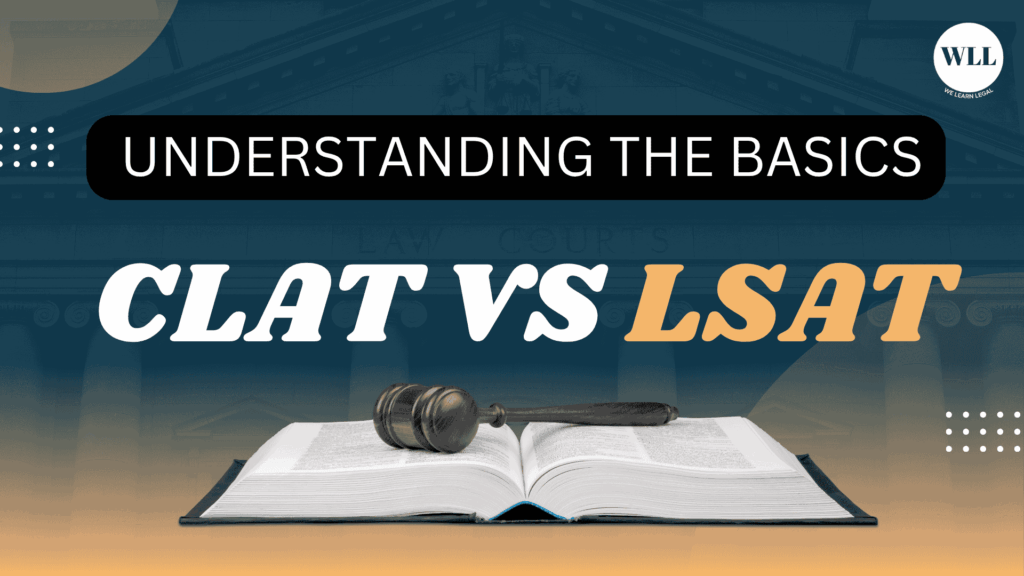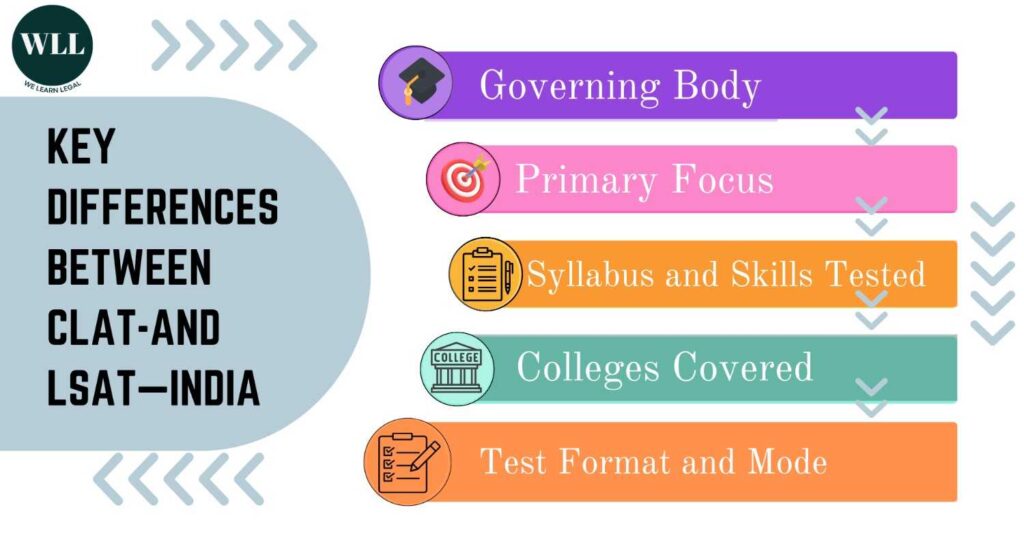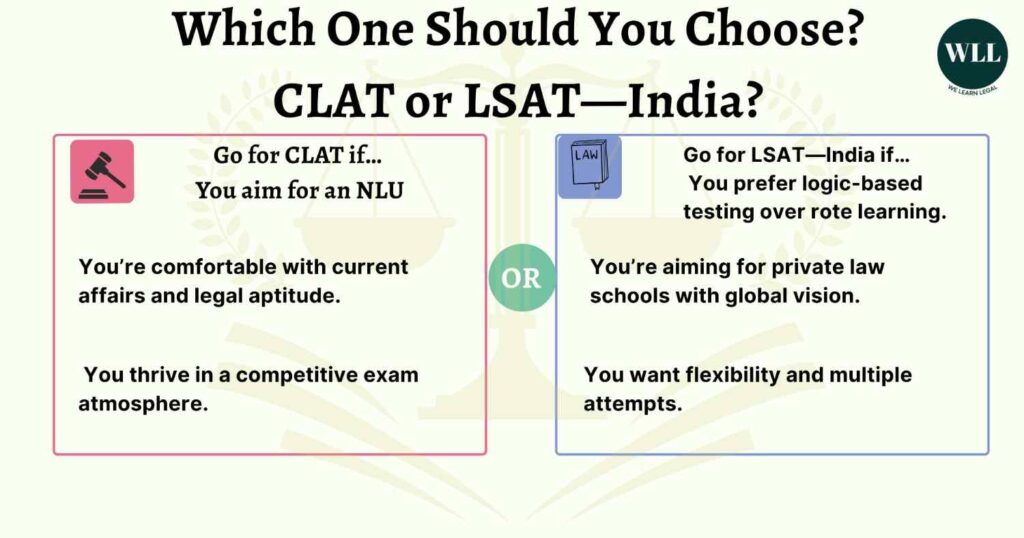In the summer of 2023, a student named Aanya from Delhi faced a dilemma shared by thousands of law aspirants across India. With dreams of walking the hallowed halls of NLSIU or becoming a legal changemaker like Karuna Nundy or Menaka Guruswamy, she sat at her study desk surrounded by prep books and counseling brochures. The question that troubled her wasn’t whether to pursue law — it was which law entrance exam to pursue: CLAT vs LSAT—India?
India’s legal education landscape has evolved significantly over the last decade. From the dominance of National Law Universities (NLUs) through CLAT to the rise of globally-networked private institutions like Jindal Global Law School that accept LSAT—India scores, aspiring lawyers now find themselves at a strategic crossroads.
This dilemma is not just academic — it is layered with personal ambitions, financial considerations, career aspirations, and the very model of legal education one envisions. In an age where legal professionals are not only appearing in courts but also driving policy, drafting international contracts, and leading CSR initiatives, the foundation built during undergraduate law education has never been more critical.
The choice between CLAT and LSAT—India is, in many ways, a reflection of the broader debate: rigid traditionalism versus global liberalism; competitive intensity versus aptitude-focused reasoning; government-run institutions versus private innovation.
With the recent legal reforms around data privacy, judicial activism during the COVID-19 pandemic, and the debates over farm laws, Indian legal consciousness is higher than ever. Students are inspired by public interest litigations, constitutional debates, and the role of the judiciary in safeguarding democracy. But before they reach courtrooms or corporate boardrooms, they must pass through the gates of their chosen law school — and for that, choosing the right entrance exam is key.This article is your compass. We break down the CLAT vs. LSAT—India debate across every possible angle — syllabus, difficulty, college acceptance, career prospects, and preparation strategy — so you can make an informed, confident decision.

Law as a Career in India: A World of Possibilities
The legal profession in India has long stood as a pillar of societal evolution, justice, and governance. From iconic courtroom battles that have shaped constitutional interpretations to the vital behind-the-scenes roles played by corporate counsels, policy drafters, and human rights advocates, law offers a career that is as diverse as it is impactful.
Traditionally seen as a pursuit for those with sharp intellect, unwavering discipline, and a passion for justice, the legal field today has broadened its horizons. The rise of start-ups, foreign direct investment, and public-private partnerships has transformed legal practice into a multidimensional career that extends far beyond the courtrooms of Tis Hazari or the chambers of the Supreme Court.
Lawyers are now advising on international arbitration, handling mergers and acquisitions, negotiating climate treaties, drafting compliance frameworks for tech firms, and even making their mark in diplomacy, politics, and journalism. Figures like Justice D.Y. Chandrachud, Arundhati Katju, or Harish Salve illustrate how the Indian legal journey can lead to national and global platforms of influence.
However, this journey starts with one fundamental choice — selecting the right law entrance examination.
Why Choosing the Right Law Entrance Exam Matters
Every profession requires a gateway — and for aspiring lawyers in India, that gateway is the law entrance exam. Yet, not all gateways lead to the same destination. CLAT (Common Law Admission Test) and LSAT—India (Law School Admission Test – India) represent two very distinct models of entry into the legal ecosystem.
CLAT, conducted by the Consortium of National Law Universities, is the traditional route, offering access to prestigious NLUs — institutions that have become synonymous with academic rigor and judicial ambition. On the other hand, LSAT—India opens doors to progressive, private institutions that are globally connected and innovation-driven, such as Jindal Global Law School and others.
Choosing the right exam isn’t just about getting into a college — it’s about aligning your strengths, values, and career vision with the right platform. A student with a flair for analytical reasoning and a dislike for rote memorization might thrive under LSAT’s structure, while someone passionate about constitutional law and courtroom advocacy may set their sights on the NLUs via CLAT.
The difference in syllabus, structure, assessment philosophy, and even campus culture makes this decision one of the most pivotal for any law aspirant.
Purpose of This Guide: CLAT or LSAT—India? Let’s Settle It.
This article is crafted to serve as a comprehensive decision-making guide for law aspirants who find themselves unsure between CLAT and LSAT—India. With hundreds of forums, opinions, and coaching modules available online, students are often overwhelmed with conflicting information.
We cut through the noise.
By offering a clear, unbiased, and deep dive into both examinations — covering eligibility, syllabus, testing style, accepted colleges, career outcomes, and student profiles — we aim to empower you with the clarity you need.By the end of this blog, you’ll not only know the difference between CLAT and LSAT—India, but you’ll also understand which one is right for you.

Understanding the Basics: CLAT vs LSAT—India
Before we begin dissecting syllabus patterns, difficulty levels, or career outcomes, it’s essential to first understand what CLAT and LSAT—India really are. While both are law entrance exams, they are fundamentally different in their philosophy, structure, and vision for legal education in India. Think of it like choosing between two very different kinds of law schools — one rooted in legacy and public service, the other in global exposure and innovation.
Let’s break them down.
What is CLAT?
The Common Law Admission Test (CLAT) is the most widely recognized law entrance exam in India. It is conducted by the Consortium of National Law Universities, a collective body of 24 premier National Law Universities (NLUs) spread across the country.
These are institutions that have consistently produced some of India’s top judges, lawyers, bureaucrats, and scholars. If you’ve heard of names like Justice Srikrishna, Advocate Menaka Guruswamy, or even Apar Gupta of the Internet Freedom Foundation — you’re likely looking at the products of NLU-type legal training.
CLAT serves as the gateway to these NLUs, which include top-ranking institutions like:
- NLSIU Bengaluru
- NALSAR Hyderabad
- WBNUJS Kolkata
- NLU Jodhpur
- NLU Delhi (Note: conducts AILET separately, but is still considered part of the NLU ecosystem)
Beyond NLUs, over 60 other private law colleges in India also accept CLAT scores, including UPES Dehradun, Amity Law School, and ICFAI Law School.
The purpose of CLAT is to evaluate a student’s reading comprehension, critical thinking, logical reasoning, current affairs knowledge, legal aptitude, and basic quantitative ability — all necessary traits for a rigorous 5-year legal journey. The exam is paper-based, conducted once a year (typically in December), and is known for its comprehension-heavy format introduced in 2020 to align with global testing standards.
In short, CLAT is for you if you’re aiming to join the league of public legal scholars, future judges, litigators, and policymakers.
b. What is LSAT—India?
The Law School Admission Test – India (LSAT—India) is a standardized aptitude test developed by the Law School Admission Council (LSAC) — the same organization that administers the LSAT used for law school admissions in the United States. In India, it is administered digitally by Pearson VUE, and it has gained substantial traction over the past decade, especially among private, globally-oriented law schools.
Unlike CLAT, LSAT—India does not test your knowledge of current affairs or legal reasoning in the traditional sense. Instead, it focuses on:
- Analytical Reasoning
- Logical Reasoning (split into two sections)
- Reading Comprehension
There’s no math, no static GK, and no legal knowledge required. The idea is to assess whether you have the critical reasoning and verbal aptitude to succeed in a high-quality law program — traits that are also essential for law schools in countries like the US, UK, or Canada.
Colleges that accept LSAT—India scores include:
- Jindal Global Law School (JGLS), Sonipat
- UPES School of Law, Dehradun
- Bennett University, Greater Noida
- IFIM Law School, Bangalore
- Vijaybhoomi School of Law, and others
Jindal Global Law School, for instance, is ranked among the top 150 law schools in the world according to the QS World University Rankings — a remarkable feat for a private Indian law school that doesn’t participate in CLAT. Students here often go on to study abroad, clerk at international courts, or work with top global law firms.
The purpose of LSAT—India is to offer a globally benchmarked, aptitude-based admission route into law — ideal for students who value international exposure, flexible curriculum design, and interdisciplinary learning.
Consider these tips:💡
- lay to Your Strengths, Not Popularity
- Many aspirants blindly follow what others are doing — don’t! If you’re strong in current affairs and legal aptitude, CLAT is for you. If you love logic games and reading comprehension, LSAT—India fits better. Focus on your natural abilities, not just “what’s more famous.”
- 👉 Related read: CLAT vs AILET: Which One Should You Choose?
| Feature | CLAT | LSAT—India |
|---|---|---|
| Full Form | Common Law Admission Test | Law School Admission Test – India |
| Conducted By | Consortium of NLUs | LSAC (via Pearson VUE) |
| Focus | Legal aptitude, current affairs, logic, math | Analytical and logical reasoning, reading |
| Colleges Covered | 24 NLUs + 60+ private institutions | 20+ private law schools |
| Frequency | Once a year (paper-based) | Multiple sessions per year (online, proctored) |
| Ideal For | Students targeting public institutions & judiciary | Students aiming for private, global legal careers |
Exam Pattern and Syllabus: CLAT vs. LSAT—India
If law is a game of strategy and intellect, the entrance exams are your qualifying match — and each one tests a different kind of player.
The CLAT and LSAT—India may both open doors to legal education, but the way they test you is entirely different. One relies on your ability to read, retain, and reason under pressure; the other emphasizes logical clarity, reading precision, and abstract thinking. Let’s break them down in detail.
CLAT: The Comprehension-Based Challenger
CLAT underwent a major overhaul in 2020. Gone are the days of memory-based questions and static legal knowledge. The new CLAT is comprehension-heavy, meaning it presents you with passages and case-style scenarios from which questions are asked.
Sections in CLAT:
- English Language
- Passages from fiction, editorials, speeches, etc.
- Vocabulary in context, inference-based questions
- Example: A passage from The Hindu discussing freedom of speech might be followed by questions on the author’s tone, main argument, or word meanings.
- Passages from fiction, editorials, speeches, etc.
- Current Affairs including General Knowledge
- Focus on comprehension-based current issues
- Questions are based on recent events (national and international), legal developments, and government policies
- Example: A passage discussing the Digital Personal Data Protection Act, 2023 could be followed by questions testing your understanding of its impact on privacy rights.
- Focus on comprehension-based current issues
- Legal Reasoning
- No prior legal knowledge required
- Scenario-based questions requiring application of legal principles to facts
- Example: You may be given a situation involving contract law or constitutional rights and asked to reason through the outcome.
- No prior legal knowledge required
- Logical Reasoning
- Argument-based questions from editorial-style passages
- Assumptions, conclusions, strengthening/weakening arguments
- Example: A paragraph on the One Nation, One Election debate may lead to reasoning questions.
- Argument-based questions from editorial-style passages
- Quantitative Techniques
- Basic math based on graphs, charts, and short sets
- Class 10 level arithmetic (ratios, percentages, time-speed-distance)
- Example: A bar graph comparing law school placements might form the basis for data interpretation questions.
- Basic math based on graphs, charts, and short sets
Exam Format:
- Duration: 2 hours
- Number of Questions: 120 MCQs (reduced from 150 in 2022)
- Marking Scheme: +1 for correct, -0.25 for incorrect answers
- Skills Tested: Reading speed, comprehension, critical reasoning, decision-making under time pressure
CLAT is ideal for students who are strong readers, well-informed about current affairs, and comfortable with rapid comprehension.
LSAT—India: The Logic-Centric Aptitude Test
LSAT—India, unlike CLAT, does not test your knowledge of law or current events. Instead, it aims to assess the skills that define a successful law student — logical precision, reading depth, and structured thinking. It’s designed more like an IQ-style test, but specialized for law.
Sections in LSAT—India:
- Analytical Reasoning
- Logic games, pattern recognition, conditional logic
- Example: “If A is sitting next to B but never next to C, and D must sit at the end…” — figure out valid seating orders.
- Logic games, pattern recognition, conditional logic
- Logical Reasoning (Part I and II)
- Argument-based multiple-choice questions
- Identify assumptions, detect flaws, draw conclusions
- Example: An argument about the effectiveness of a law banning single-use plastics, followed by a series of critical reasoning questions.
- Argument-based multiple-choice questions
- Reading Comprehension
- Long, dense passages (legal, philosophy, history, etc.)
- Followed by deep comprehension and reasoning questions
- Example: A passage from Ambedkar’s writings or a legal philosophy article, with questions about the author’s perspective, implications, or analogies.
- Long, dense passages (legal, philosophy, history, etc.)
Exam Format:
- Duration: 2 hours 20 minutes
- Mode: Online, proctored at home
- Marking Scheme: No negative marking
- Scoring: Scaled between 420 and 480
LSAT—India is for students who are strong in logic, patient with analysis, and prefer not to rely on memorizing facts or current affairs.
| Feature | CLAT | LSAT—India |
|---|---|---|
| Format | MCQ, paper-based | MCQ, online-proctored |
| Duration | 2 hours | 2 hours 20 minutes |
| Negative Marking | Yes (-0.25) | No |
| GK/Current Affairs | Yes | No |
| Legal Reasoning | Yes (scenario-based) | No (abstract logic only) |
| Math Component | Yes (basic data interpretation) | No |
| Reading Comprehension | Yes (passage-based across sections) | Yes (dedicated section + logical reasoning-based) |

Key Differences Between CLAT and LSAT—India
While both CLAT and LSAT—India aim to assess a candidate’s suitability for a legal education, they differ significantly in their purpose, structure, and institutional ecosystem. Understanding these differences is not just about cracking an entrance exam — it’s about aligning your educational path with your strengths, ambitions, and learning preferences.
Let’s explore the key contrasts:
Governing Body
CLAT is organized by the Consortium of National Law Universities, a group formed by the NLUs themselves to standardize law admissions in India. It represents India’s public legal education model.
LSAT—India, on the other hand, is conducted by the Law School Admission Council (LSAC) and delivered by Pearson VUE, reflecting a more international, aptitude-based approach rooted in global law school admission standards.
Primary Focus
CLAT is India-centric — it’s your gateway to the top publicly funded National Law Universities and a few reputed private law colleges.
LSAT—India focuses on select private law schools, particularly those emphasizing global curriculum, interdisciplinary learning, and international legal exposure. Institutions like Jindal Global Law School and UPES Dehradun are examples.
Syllabus and Skills Tested
CLAT tests:
- English comprehension
- Current affairs and general knowledge
- Legal reasoning
- Logical reasoning
- Basic quantitative techniques
LSAT—India, by contrast, tests:
- Analytical reasoning
- Logical reasoning (2 sections)
- Reading comprehension
It avoids current affairs, legal principles, and math altogether — focusing purely on critical thinking.
🏫 Colleges Covered
CLAT is accepted by:
- 24 National Law Universities (NLUs) — including NLSIU, NALSAR, NUJS, etc.
- 60+ private colleges — including Amity Law School, ICFAI, UPES (also accepts LSAT).
LSAT—India is accepted by:
- 20+ private law schools in India, most notably Jindal Global Law School (JGLS), IFIM Law School, and Vijaybhoomi School of Law.
Test Format and Mode
CLAT is a paper-based test, conducted once a year. It requires intense focus, time management, and reading comprehension.
LSAT—India is online and proctored remotely, allowing students to take the test from the safety of their home — especially useful in a post-pandemic academic world. It also offers multiple test windows per year, providing flexibility.
Frequency
- CLAT is held once a year, typically in December.
LSAT—India is held multiple times a year, with the option to pick your preferred test window — usually in January and May.
Summary Table: CLAT vs. LSAT—India
| Feature | CLAT | LSAT—India |
|---|---|---|
| Governing Body | Consortium of NLUs | LSAC (Pearson VUE) |
| Primary Focus | Public/National Law Universities | Private Law Schools |
| Syllabus | Legal aptitude, GK, math, logic | Critical thinking, logic, comprehension |
| Colleges Covered | 24 NLUs + 60+ private institutions | 20+ private law schools |
| Test Format | Paper-based | Online, remotely proctored |
| Frequency | Once a year | Multiple times a year |
Colleges and Career Prospects: Where Your Law Degree Can Take You
Choosing between CLAT and LSAT—India is, at its core, a question of where you want to study and who you want to become. Law school is more than just lectures and casebooks — it’s where your professional identity is shaped, where networks are formed, and where lifelong mentors and peers are found.Let’s explore what each path offers when it comes to colleges and career impact.
CLAT: The Gateway to India’s Premier Law Institutions
CLAT opens doors to the 24 National Law Universities (NLUs) — the elite public institutions created to reform legal education in India. These NLUs have become synonymous with academic rigor, constitutional values, and competitive excellence.
Among the top NLUs:
- NLSIU Bengaluru – Often called the “IIT of law”, consistently ranked #1.
- NALSAR Hyderabad – Known for its vibrant campus and strong litigation culture.
- WBNUJS Kolkata – Offers solid internships and has strong mooting culture.
- NLU Jodhpur, NLU Bhopal, GNLU Gandhinagar – Renowned for corporate placements and government policy exposure.
What kind of careers do NLU graduates pursue?
- Corporate law: Top-tier law firms like AZB & Partners, Trilegal, Cyril Amarchand Mangaldas, and Shardul Amarchand Mangaldas regularly recruit from NLUs.
- Litigation: Many NLU graduates clerk at the Supreme Court or High Courts, or start practice under leading senior advocates.
- Government & policy: Several alumni go on to become judges, IAS/IPS officers, or work with think tanks and ministries.
- Academia & international careers: Alumni have been Rhodes Scholars, Fulbright recipients, and professors at Ivy League institutions.
In short, a top NLU can be a game-changer, especially for students from modest backgrounds looking for high-return public legal education.
LSAT—India: The Rise of Global Private Law Schools
LSAT—India offers a completely different ecosystem — one built on global benchmarking, interdisciplinary education, and international exposure.
Top law schools accepting LSAT—India scores include:
- Jindal Global Law School (JGLS) – Ranked among the top 150 law schools in the world by QS Rankings. Known for its diverse faculty, international exchange programs, and tie-ups with institutions like Harvard, Yale, and NYU.
- IFIM Law School, Bangalore – Focuses on emerging areas like fintech law, data privacy, and startup law.
- Alliance University, UPES Dehradun, Vijaybhoomi School of Law, and others – Known for specialized programs, modern infrastructure, and industry-focused curriculums.
Career opportunities through LSAT—India colleges:
- Corporate jobs: JGLS students are placed in law firms like Khaitan & Co, Luthra & Luthra, and international firms in Singapore, UAE, and the UK.
- International internships: Many students secure internships at UN bodies, WTO, and international NGOs through university tie-ups.
- Policy & research: JGLS students often work with global think tanks, contribute to law journals, and pursue LLMs abroad.
- Entrepreneurship: The emphasis on innovation has also led many students to start legal-tech companies, policy consultancies, or go into arbitration and mediation.
Though LSAT—India colleges are private and fee structures are higher, they offer world-class exposure, small class sizes, and excellent student-faculty ratios — features that are hard to find in many NLUs.
Career Impact: It’s Not Just the Exam, It’s the Ecosystem
Let’s be honest: your law school’s brand does matter — but it’s not the only thing that shapes your career.
- A student from NLSIU who actively moots, researches, and interns can land a top job — but so can a JGLS student with strong academics, great networking, and international publications.
- While NLUs give a head start in litigation and competitive exams, LSAT-based schools offer advantages in global mobility, policy roles, and niche corporate domains.
In essence, career impact depends on three things:
- The college you attend
- The network you build
- The effort and focus you put in during your 5-year journey
Whether it’s a courtroom in Delhi, a boardroom in Mumbai, or an LLM seminar at Cambridge — your law school can shape your trajectory. But the real magic happens when you take charge of your own path.
Consider these tips:💡
- Attempt Both Exams for a Safety Net
- Why limit yourself to one? Thousands of students attempt both CLAT and LSAT—India to increase their chances of landing in a top law school. The exam timelines often complement each other, making dual prep a smart, low-risk move.
- 👉 Must-read: CLAT vs SLAT: Which Exam is Easier for You?
Difficulty Level and Preparation: What Does It Take to Crack CLAT or LSAT—India?
When it comes to law entrance exams, most aspirants naturally ask, “Which exam is tougher — CLAT or LSAT—India?” The answer, as with most things in law, is: It depends.Each test challenges a different skill set. One rewards awareness and speed; the other rewards depth and precision. Let’s break this down.
CLAT: Tougher on Paper — Literally and Figuratively
CLAT is notoriously competitive. In 2024, over 60,000+ students appeared for roughly 2,800 seats across NLUs. The math is brutal — that’s around a 4-5% selection rate for top NLUs.
What makes CLAT tough?
- Comprehension-Heavy Questions: Every section now involves passages — even math! You must read quickly, interpret complex language, and answer with accuracy.
- Current Affairs and GK: This section is unpredictable. From the Israel-Hamas conflict to the Supreme Court’s verdict on same-sex marriage in India, you need to be up-to-date with national and international headlines, government schemes, and legal developments.
- Legal Reasoning: While you don’t need prior legal knowledge, applying logic to legal principles in timed conditions is demanding.
- Math and Time Management: Even basic math becomes a challenge when tucked inside a word problem and placed under pressure.
🧠 Verdict: CLAT is considered tougher overall due to its broad scope, time constraints, and cut-throat competition — but it’s also manageable with a focused prep strategy.
LSAT—India: Easier on Facts, Harder on Thinking
LSAT—India is often described as “deceptively simple.” There’s no current affairs, no legal GK, no math. But don’t be fooled — it demands deeper focus and sharper logic.
What makes LSAT—India challenging?
- No Rote Learning: You can’t “study” current affairs or memorize legal maxims. It’s all about how well you can think and read.
- Abstract Logic: Sections like Analytical Reasoning (logic games) require you to spot patterns, rules, and logical sequences. Think of Sudoku on steroids — but in words.
- Time Discipline: LSAT gives you fewer questions, more time per question, but each one is intellectually loaded. You need to stay calm, sharp, and deeply attentive.
Verdict: LSAT—India is less stressful in terms of content memorization, but it’s ideal for students who enjoy puzzles, reasoning, and deep reading.
Preparation Duration and Strategy
Whether you’re taking CLAT or LSAT—India, preparation time typically ranges from 6 months to 1 year, depending on your background and current skill level.
CLAT: Recommended Prep Material
- English & Comprehension:
- Word Power Made Easy by Norman Lewis
- The Hindu Editorials for vocabulary and comprehension
- Word Power Made Easy by Norman Lewis
- Current Affairs & GK:
- GK Today, Drishti IAS monthly compilations, The Hindu, Indian Express
- Follow current legal news: Supreme Court verdicts, parliamentary bills
- GK Today, Drishti IAS monthly compilations, The Hindu, Indian Express
- Legal Reasoning:
- Universal’s Guide to CLAT
- Legal Edge Modules (Career Launcher, CLAT Possible, LawPrep)
- Universal’s Guide to CLAT
- Quantitative Techniques:
- RS Aggarwal (Class 10 level)
- Practice DI (Data Interpretation) sets under time limits
- RS Aggarwal (Class 10 level)
- Mock Tests:
- Crucial. Aim for 50+ mocks from platforms like CLAT PG, Law Prep, Oliveboard.
- Crucial. Aim for 50+ mocks from platforms like CLAT PG, Law Prep, Oliveboard.
LSAT—India: Recommended Prep Material
- Logical & Analytical Reasoning:
- LSAT India Official Prep Guide
- Powerscore LSAT Logic Games Bible (for deeper practice)
- Manhattan Prep LSAT series
- LSAT India Official Prep Guide
- Reading Comprehension:
- Practice with complex texts (philosophy, economics, sociology)
- Read from sources like The Economist, Aeon Essays, New Yorker
- Practice with complex texts (philosophy, economics, sociology)
- Coaching Support:
- Jindal Global Law School often offers LSAT workshops
- Career Launcher and IMS offer dedicated LSAT prep
- Jindal Global Law School often offers LSAT workshops
- Official Practice Tests:
- Use Discover Law India’s free LSAT sample papers
- Use Discover Law India’s free LSAT sample papers
Simulate the online, proctored environment beforehand
Which Prep Strategy Works for You?
| If you are… | Consider… |
|---|---|
| A strong reader with interest in law & news | CLAT |
| A logical thinker who enjoys puzzles & patterns | LSAT—India |
| Not great with current affairs or math | LSAT—India |
| Looking to enter the NLU ecosystem | CLAT |
| Interested in a global/private legal career path | LSAT—India |
Fees and Application Timeline: What to Expect and When to Apply
When preparing for law entrance exams, it’s not just about the content — it’s also about planning your calendar and budgeting your expenses. Both CLAT and LSAT—India have a relatively affordable application fee, but they differ significantly in their test frequency and scheduling flexibility.
Let’s break it down.
CLAT: Once-a-Year, High-Stakes Test
- Application Fee: ₹4,000 (₹3,500 for SC/ST/BPL candidates)
- Mode: Offline (paper-based test)
- Application Period: Generally opens around July–August
- Exam Month: December (as of 2023 onwards)
CLAT is held only once a year, which makes it a high-pressure exam. If you miss the date, underperform, or fall ill, you’ll need to wait an entire year to reapply. This “one-shot” nature makes mock tests and consistent prep extremely important.
Example: In 2024, the CLAT UG exam was conducted on December 3, and the application window ran from July to November.
LSAT—India: Flexible and Multi-Session
- Application Fee: ₹3,999
- Mode: Online (remote-proctored from home)
- Testing Windows: Usually twice a year — in January and May
What makes LSAT—India stand out is its flexibility:
- Students can choose their preferred test date within a testing window.
- If you’re not happy with your January performance, you can attempt it again in May.
- The scores remain valid for a full admission cycle (for most colleges).
This format offers psychological ease — you’re not stuck with a single chance and can build a strategic plan to improve.
Example: For the 2024 cycle:
- January test was held between January 20–21
- May session is scheduled for May 16–19
- Applications for May 2024 close on May 2
CLAT vs. LSAT—India: Flexibility Comparison
| Feature | CLAT | LSAT—India |
|---|---|---|
| Application Fee | ₹4,000 | ₹3,999 |
| Exam Mode | Offline (pen-and-paper) | Online (remote-proctored) |
| Exam Frequency | Once a year | Multiple sessions (Jan, May) |
| Resit Option (Same Year) | ❌ No | ✅ Yes (take another session) |
| Ideal for… | Students with fixed timeline | Students who want scheduling flexibility |
Why Does Flexibility Matter?
Let’s say you’re in Class 12 and preparing for boards + law entrances. LSAT—India lets you test yourself in January, assess your performance, and refocus for CLAT or retake LSAT in May. That breathing space can be a game-changer for mental health and strategy.
On the other hand, if you’re aiming for top NLUs, CLAT remains your non-negotiable — and that means treating it as your main academic priority during the year.

Which One Should You Choose? CLAT or LSAT—India?
By now, you’ve understood that CLAT and LSAT—India aren’t just different exams — they represent two different mindsets, institutional cultures, and learning styles. Choosing between them isn’t about which is easier or harder, but which one aligns better with you.
Let’s simplify the decision-making.
Go for CLAT if…
You aim for an NLU.
The most obvious reason to appear for CLAT is if your dream is to study at one of India’s premier National Law Universities — be it NLSIU Bengaluru, NALSAR Hyderabad, or NUJS Kolkata. These are the gold standard of public legal education in India.
You’re comfortable with current affairs and legal aptitude.
CLAT rewards students who love to read newspapers, track government policies, understand legal controversies, and engage with public discourse. If you often find yourself debating Supreme Court verdicts or analysing political reforms — CLAT is your natural turf.
You thrive in a competitive exam atmosphere.
CLAT’s single-day, all-India test format is rigorous and demanding. If you’ve handled pressure well in previous exams (like NTSE, Olympiads, or CUET mocks), you’ll likely do well here.
Real-Life Example:
Aarav, a Class 12 student from Jaipur, was always interested in constitutional law and followed the Uniform Civil Code debate closely. His target was NLU Delhi (via AILET) and NALSAR. He enjoyed reading editorials, was great with deadlines, and didn’t mind waking up at 5 am for mocks. CLAT was the obvious path for him — and he cracked NALSAR with AIR 87.
Go for LSAT—India if…
You prefer logic-based testing over rote learning.
If you dislike mugging up facts and instead enjoy solving puzzles, decoding patterns, and building logical arguments, LSAT—India is made for you. You don’t need to study current affairs or worry about math — just sharpen your analytical skills.
You’re aiming for private law schools with global vision.
Top LSAT—India colleges like Jindal Global Law School (JGLS), IFIM, or UPES offer international faculty, liberal arts integration, and exchange programs with universities abroad. If your dream includes an LL.M. from Harvard or internships at UN bodies, this route provides excellent exposure.
You want flexibility and multiple attempts.
Unlike CLAT’s one-shot exam, LSAT—India offers two sessions a year (January and May), with remote-proctored testing from home. If you’re juggling school, coaching, or just want a second chance — LSAT’s scheduling flexibility is a big advantage.
Real-Life Example:
Sara, a Humanities student from Pune, found GK stressful and hated math. But she was brilliant in critical thinking and had scored 99 percentile in verbal reasoning on SAT practice tests. She focused her prep on LSAT—India and got admission into JGLS, later securing an internship at the International Bar Association (IBA) in London during her third year.
Still Not Sure? Here’s a Quick Comparison Based on Personality
| If you are… | Choose… |
|---|---|
| A current affairs junkie who loves debate and news | CLAT |
| A puzzle-lover who enjoys logic and pattern solving | LSAT—India |
| Aiming for government or public service legal careers | CLAT |
| Interested in international law or global policy | LSAT—India |
| More confident with multiple chances at entrance exams | LSAT—India |
| Want to compete for top Indian public law colleges | CLAT |
Can You Attempt Both? Absolutely — and Many Students Do
A common myth among law aspirants is that they must choose either CLAT or LSAT—India. But here’s the truth: you can — and perhaps should — attempt both. In fact, thousands of students appear for both exams every year, and doing so can increase your chances of landing in a top law school while giving you the freedom to explore different academic ecosystems.
Let’s understand why this is a smart strategy, not a confusing one.
Two Exams, Two Mindsets — But One Goal
CLAT and LSAT—India test different skills, but their timelines often complement each other.
- CLAT is conducted once a year in December.
- LSAT—India offers two sessions, usually in January and May.
This spacing gives you the opportunity to:
- Attempt LSAT in January as a first exposure and confidence booster.
- Give CLAT your all in December.
- Re-attempt LSAT in May if you want to improve your score or didn’t make your preferred CLAT college.
Rather than competing with each other, they can work in tandem, creating a backup plan and widening your admission pool.
How to Strategically Prepare for Both
If you’re aiming to attempt both CLAT and LSAT—India, it helps to divide your preparation into two overlapping layers:
CLAT Strategy
- Focus on reading speed, legal reasoning, current affairs, and math basics.
- Practice mock tests regularly to build stamina and accuracy.
- Stay consistent with daily news analysis, especially Supreme Court and constitutional law developments.
LSAT Strategy
- Dedicate time to puzzle-solving, pattern recognition, and deep reading comprehension.
- Practice from logic-heavy prep books like Powerscore and LSAC’s official guides.
Train yourself to focus without distraction for long periods — LSAT questions are dense and need calm concentration.
Consider these tips:💡
- Start with CLAT preparation in earnest (since it requires broader content), and then layer in LSAT practice closer to its test dates. Since LSAT does not test current affairs or math, you won’t need to double the effort — just sharpen your reasoning skills.
Dual Benefits: Safety Net + Career Options
Attempting both exams gives you:
- A wider set of colleges to apply to — from NLSIU to JGLS to UPES.
- A backup plan in case CLAT doesn’t go as expected.
- A clearer understanding of your strengths and preferences, especially if you do better on one format than the other.
Many top-performing students use LSAT-India to secure admission into JGLS or other reputed private colleges while still pursuing their NLU dreams through CLAT.
In Short: Think Broad, Act Smart
| Strategy | Benefit |
|---|---|
| Prepare for CLAT’s wide syllabus | Builds stamina, knowledge, and exam discipline |
| Train for LSAT’s logic-heavy style | Sharpens reasoning, opens international pathways |
| Attempt both | Maximizes opportunities, reduces stress |
Final Verdict: CLAT vs. LSAT—India — There’s No One-Size-Fits-All
After diving deep into the differences between CLAT and LSAT—India — their structure, syllabus, colleges, career paths, and preparation strategies — you might still be asking the million-rupee question:
“Which one is better?”
Here’s the honest answer: There’s no “better” exam — only the one that’s better for you.
It all comes down to three things:
- Your career goals
- Your preparation style
- The type of law school experience you’re seeking
If your dream is to argue in the Supreme Court, work with government think tanks, crack judicial services, or be a public-interest lawyer — then CLAT and the NLU route might be a better fit.
If you envision a career in corporate law, policy research, global human rights, or even an international LLM in the future — LSAT—India and institutions like JGLS may offer a more aligned pathway.
And if you’re still unsure?
Consider these tips:💡Take Both, Play to Your Strengths
- In a world where competitive exams are unpredictable — where even the best-prepared students can fall short due to nerves or a bad day — appearing for both CLAT and LSAT—India is a smart, risk-proof strategy.
- You increase your chances of admission
- You get access to two different academic ecosystems
- You give yourself the power to choose from offers, rather than cling to one outcome
- Many students who ace both exams eventually pick the college that aligns with their personality, finances, and long-term ambitions — not just the one that sounds most prestigious.
FAQs: CLAT vs. LSAT—India – Your Doubts, Answered
Q1. Can I get into an NLU through LSAT—India?
No.
NLUs (National Law Universities) do not accept LSAT—India scores. The only way to get into an NLU is by appearing for CLAT (for 22 NLUs) or AILET (for NLU Delhi).
However, some other prestigious private law colleges, such as Jindal Global Law School (JGLS), UPES, and IFIM, accept LSAT—India scores and offer a completely different style of legal education — one with more emphasis on global exposure, research, and interdisciplinary learning.
Q2. Is JGLS better than NLUs?
It depends on what you’re looking for.
Top NLUs like NLSIU, NALSAR, and NUJS offer elite academic training, legacy alumni networks, and are great for students aiming at judiciary, litigation, and government careers.
JGLS (Jindal Global Law School) is ranked among the top 150 law schools globally (QS World Rankings), offers world-class faculty, exchange programs, and prepares students for international law, research, and policy roles.
In terms of infrastructure, faculty-student ratio, global partnerships, and liberal education — JGLS matches or even surpasses some NLUs. But in terms of public sector opportunities, competitive exams, and courtroom culture, NLUs still dominate.
✅ Bottom line: It’s not about “better” — it’s about which is better for your career goals
Q3. Is LSAT—India easier than CLAT?
Yes and no.
LSAT—India is less content-heavy — there’s no math, no current affairs, and no legal knowledge required. It focuses purely on logical reasoning, analytical puzzles, and reading comprehension.
CLAT, in contrast, tests a broader range of subjects, including current affairs, legal aptitude, and quantitative techniques — and is considered more competitive due to the massive number of applicants.
However, LSAT requires deeper concentration and precision, especially in logic-based questions. Some students find that harder than memorizing facts. So it’s easier in terms of syllabus, but not necessarily in terms of mental skill or stamina.
Q4. Which exam has a better ROI (Return on Investment)?
This depends largely on:
The college you get into
Your career aspirations
Scholarship opportunities
Your performance during law school
If you get into a top 5 NLU, the ROI is typically very high — with many students landing corporate jobs starting at ₹12–18 LPA, or cracking judiciary/UPSC exams within a few years.
If you get into JGLS through LSAT—India, the fees are higher, but the ROI can be excellent if you:
Secure international internships or LLMs
Pursue a policy or think-tank career
Land corporate law roles in top-tier firms or global companies
Many JGLS students also receive generous scholarships (up to 100%), which significantly enhances the ROI.
Tip: Always look at placements, alumni achievements, academic offerings, and scholarships — not just the entrance exam
Conclusion: Your Legal Journey Begins with the Right Choice
Choosing between CLAT and LSAT—India is more than just picking an exam — it’s about choosing the educational environment, career trajectory, and lifestyle that best suits your strengths and aspirations.
Both exams are valid, valuable, and capable of opening doors to successful legal careers. CLAT gives you access to India’s most prestigious public law schools, rooted in tradition and national service. LSAT—India offers entry into globally-oriented private institutions that emphasize innovation, research, and international exposure.
The “right” exam isn’t the one your friend is taking or the one that seems more popular — it’s the one that aligns with your academic comfort, learning style, and professional dreams.
If you’re still unsure, remember — you can appear for both. Many students do, and it’s a strategic way to keep your options open and discover where you truly belong.
At the end of the day, your hard work, consistency, and curiosity will shape your legal career far more than any single exam. So pick your path, plan your preparation, and take that first bold step toward a future in law.
The courtroom, the boardroom, the newsroom, or the classroom — wherever you end up, your legal journey starts here








